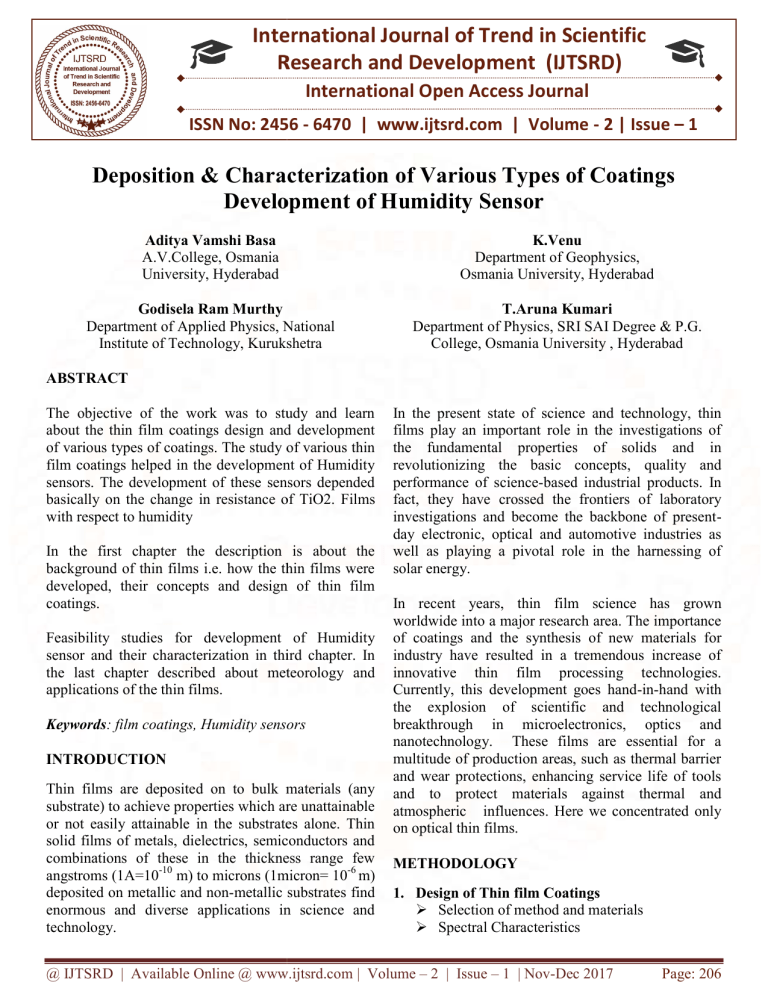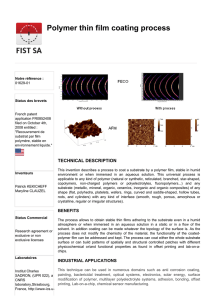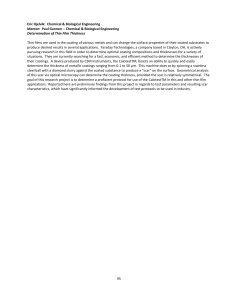
International Journal of Trend in Scientific
Research and Development (IJTSRD)
International Open Access Journal
ISSN No: 2456 - 6470 | www.ijtsrd.com | Volume - 2 | Issue – 1
Deposition & Characterization of Various Types of Coatings
Development of Humidity Sensor
Aditya Vamshi Basa
A.V.College, Osmania
University, Hyderabad
K.Venu
Department off Geophysics,
Osmania University, Hyderabad
Godisela Ram Murthy
Department of Applied Physics, National
Institute of Technology, Kurukshetra
T.Aruna Kumari
Department of Physics, SRI SAI Degree & P.G.
College, Osmania University , Hyderabad
ABSTRACT
The objective of the work was to study and learn
about the thin film coatings design and development
of various types of coatings. The study of various thin
film coatings helped in the development of Humidity
sensors. The development of these sensors depended
basically on the change
ge in resistance of TiO2. Films
with respect to humidity
In the first chapter the description is about the
background of thin films i.e. how the thin films were
developed, their concepts and design of thin film
coatings.
Feasibility studies for development of Humidity
sensorr and their characterization in third chapter. In
the last chapter described about meteorology and
applications of the thin films.
Keywords:: film coatings, Humidity sensors
INTRODUCTION
Thin films are
re deposited on to bulk materials (any
substrate) to achieve properties which are unattainable
or not easily attainable in the substrates alone. Thin
solid films of metals, dielectrics, semiconductors and
combinations of these in the thickness range few
angstroms (1A=10-10 m) to microns (1micron= 10-6 m)
deposited on metallic and non-metallic
metallic substrates find
enormous and diverse applications in science and
technology.
In the present state of science and technology, thin
films play an important role in the investigations of
the fundamental properties of solids and in
revolutionizing the basic concepts, quality and
performance of science-based
based industrial products. In
fact,, they have crossed the frontiers of laboratory
investigations and become the backbone of presentpresent
day electronic, optical and automotive industries as
well as playing a pivotal role in the harnessing of
solar energy.
In recent years, thin film science has
ha grown
worldwide into a major research area. The importance
of coatings and the synthesis of new materials for
industry have resulted in a tremendous increase of
innovative thin film processing technologies.
Currently, this development goes hand-in-hand
hand
with
the explosion of scientific and technological
breakthrough in microelectronics, optics and
nanotechnology. These films are essential for a
multitude of production areas, such as thermal barrier
and wear protections, enhancing service life of tools
and to protect materials against thermal and
atmospheric influences. Here we concentrated only
on optical thin films.
METHODOLOGY
1. Design of Thin film Coatings
Selection of method and materials
Spectral Characteristics
@ IJTSRD | Available Online @ www.ijtsrd.com | Volume – 2 | Issue – 1 | Nov-Dec
Dec 2017
Page: 206
International Journal of Trend in Scientific Research and Development (IJTSRD) ISSN: 2456-6470
Environmental conditions
Requirement / application
Selection of Method
substrate in suitable fixture or zig and load the work
holder. Masking is must for best uniformity of
coating.
Many types of deposition methods for thin film
coating mainly those are
Achieving of vacuum
Open the backing valve. The pressure should fall
steadily to less than 0.1 torr as the diffusion pump
is evacuated. Allow the cooling supply to flow.
Switch on the diffusion pump, close backing valve
and open roughing slowly. Select GH2 in pirani
gauge.
If pressure less than 0.1 torr. Close the roughing
and open backing valve.
Slowly open the baffle valve (high vacuum valve).
As soon as the pressure starts rising in pirani GH1.
And we may get high vaccum (i.e., 10-7 torr)
High tension cleaning
The static charge will affect the coating uniformity
and adherence. In order to remove the static charge
we use the High Tension cleaning. In the H.T
cleaning the glow discharge removes any absorbed
vapors and gases from the chamber internal surface.
Close the high vacuum and open the baffle valve
half. Switch on the H.T. button.
Apply the low voltage from 0 to 160V or high
current about 3 amps and increase it slowly.
Now apply the air in to the chamber through
needle valve and observe the pressure in the
chamber on gauge (0.1). Then rotate the substrate.
Due to applied voltage to the aluminum foil it
produce ions, bombards with the air molecules in
the chamber takes place Glow discharge.
After 5 to 7 min, close air admittance valve and
switch off the H.T cleaning button.
On the completion of H.T cleaning, bring the
variac to zero position.
Close the air admittance valve and open baffle
valve slowly keeping the backing pressure from
rising above 0.2 torr.
1) Physical vapor deposition method
1) Thermal evaporation
2) EB-gun
3) Sputtering
4) Ion deposition
2) Chemical vapor deposition methods
1) Electrode Deposition
2) Chemical vapor
3) Sol gel
4) Spray paralysis
Selection of Material
1. Substrate Material: Optical Glass (for optical
coatings)
2. Substrate cleaning material: Iso propyl alcohol,
teefal and acids (HCl).
3. Substrate polishing material: Cerium Oxide
4. Coating materials
• Metals: Gold, Silver, Aluminum, Copper,
Inconel, Platinum, Nickel.
• Dielectrics:
Silicón dióxido (SiO2),
Aluminum Tri oxide (Al2O3)
• Conductors: Indium tin oxide (In2O3), Alloy
of indium oxides etc.
• Semiconductors: Germanium, Silicon
• Fluorides: Magnesium fluoride etc
2. EXPERIMENTAL PROCEDURE
Cleaning procedure of the substrate
Dip the substrate in the Dilute HCL, Then wash
the substrate in ordinary water
Clean the substrate with Teepol soap solution;
again wash the substrate.
Dip the substrate in distil water and Dry the
substrate
Finally clean the substrate in ultrasonic method
using alcohol.
Loading of substrate in coating plant
First we must choose the suitable fixture for the
substrate, because different size and shape of
substrates used for different applications. Now fix the
Apply L.T. (Low Tension) to the material
Switch on L.T. by selecting rotary switch, CB and
L.T electrode selector switch.
Rotate the evaporation source selector hand wheel
until the required position is numbered. Its
position also can be verified through the window.
Slowly turn up the variac with the source shutter
covered and observe the evaporation through the
front window when evaporant is just melt.
Uncover the source by means of shutter control
knob, unless initial wetting of filament is needed
@ IJTSRD | Available Online @ www.ijtsrd.com | Volume – 2 | Issue – 1 | Nov-Dec 2017
Page: 207
International Journal of Trend in Scientific Research and Development (IJTSRD) ISSN: 2456-6470
in which case, leave the source covered until this
is complete.
Repeat the process with each filament if
necessary, zero variac before changing position of
the turret.
When the evaporation is completed shutter the
source, zero the variac switch off the L.T.
(20Volts 170 Amps continuous, 200Amps
intermittant) and C.B.
Open the air admittance valve, raise the chamber
selecting hoist up.
Unload the work holder. Handle the fresh films
with care.
Shut down the unit
Evacuate the chamber down to 10-4, and then close
the high vaccum valve.
Switch off the pirani/penning and diffusion pump.
Run the rotary pump for a period of 15-25 min
keeping backing valve open. Close the backing
valve and switch off rotary pump and close the
cooling water supply.
Switch off the main switch.
Principle of glow discharge:
Glow discharge is used to remove the dust
particles and atmosphere effects. When applied
the (H.T) voltage to the anode and cathode, at
chamber Low pressure up to 4*10^-4such as .Due
to high voltage ionization will take place and,
Highly positive ions moved to the cathode, and
electrons (negative charge particles) ,moved to the
anode .The below figure shows the diagram of
glow discharge.
there is attraction force between the neutral atoms
and substrate.
3. THIN FILM COATING
HIGH REFLECTION COATING
If we deposit a material of higher refractive index
than that of glass substrate (n=1.52), then we can
increase the reflectance of bare substrate at certain
wavelength depending up on optical thickness of the
film.
The first condition is that the refractive index should
be greater than that of incident medium and substrate
i.e. n0 < ns< nf
Consider such a coating on a substrate as shown in
figure 2.
Figure 2
For maximum reflectance, the interference between
the rays reflected from air-film and film-substrate
interfaces should be constructive interference,
i.e. = 2𝑛 𝑡 = (2𝑁 + 1) /2 (normal incidence)
where N is an integer
For N=0,
𝑡=
Optical thickness = nf × t = / 4 i.e. quarter wave
thick.
Fig 1
Then when the velocity of positive ions is
impinges or bombardment to the cathode, at the
collision place, neutral ions will eject from the
cathode. That ions remove the dust particles from
the substrate. this is because of before going to the
load the substrate we did rubbing ,so that electro
static force will create on the substrate so that the
By depositing a quarter wave thick Al on glass
(1.52@550nm) we can increase reflectance from 80%
(bare substrate) to 85-92 %.
Fabrication of High Reflection Coating
Material:
(99.9% pure)
Aluminum
@ IJTSRD | Available Online @ www.ijtsrd.com | Volume – 2 | Issue – 1 | Nov-Dec 2017
in
wire
form
Page: 208
International Journal of Trend in Scientific Research and Development (IJTSRD) ISSN: 2456-6470
Protection coating: Silicon monoxide (SiO) in
pallet form
Resistance source:
helical filament and boat
This coating has done in thermal plant (“HIND
HIVAC” high vacuum coating plant). So generally
every coating follows the same procedure but differ in
resistance source. And before apply the low tension to
SiO, must enter the air into the chamber.
Results
Table 1
WAVELENGTH
S.No
REFLECTANCE%
(nm)
1.
400
93.9
2.
450
94.0
3.
4.
5.
6.
7.
500
550
600
650
700
94.2
94.3
94.2
93.6
92.9
It depends for its operation on almost complete
elimination of the light at the upper and lower of the
two surfaces of the film n1.For complete elimination
of two beams ,the reflected intensities at the upper and
the lower boundaries of the film should be equal
.which implies that the ratio of the refractive at each
boundary should be equal;
no/n1=n1/n2;
n1=
n0*n2.
This is the amplitude condition which shows that the
film indexn1, should be intermediate between the
indices of air and glass.
Anti-reflective or antireflection (AR) coatings are a
type of optical coatings applied to the surface of
ANTI REFLECTING COATING
Single layer antireflection coating:
When a beam m of light traveling in air, refractive
index, passes through the a glass plate, refractive
index n2,a part of incident light will be reflected on
the front an rear sufaces , as shown schematically.The
reflectance R of a glass/air interface, defined as, the
reflected intensity to the incident intensity ,is a
function of the difference in the refractive indices of
the media and may be expressed for normal incident
as:
R=(no-n1)/(n0+n1)2
With ordinary glass plate n2=1.52 the original beam
of light is decreased in intensity by this reflected
amount ,approximately 4.1%per surface ,making
total8.2%.If approximate thin films, refractive index
n1,are deposited on the surfaces, these reflection can
be reduced, resulting in an effective improvement in
the transmission of the glass. This process shown
schematically in the below figure, is known as
antireflection coating on the glass plate.
lenses or optical devices to reduce reflection. The
glass elements in compound lens have a transmittance
of only 92. The net transmittance of even a modest
number of elements in series can therefore be quite
low. Additionally, part of the light reflected at various
surfaces eventually reaches the focal plane, where it
appears as ghosts. Thus reducing the contrasts of
images is especially important for zoom lenses used in
photography, which would be completely unusable
without AR coatings.
In other applications, the primary benefit is the
elimination of the reflection itself, such as a coating
on eyeglass lenses that makes the objects more
visible. In complex systems such as a telescope, the
@ IJTSRD | Available Online @ www.ijtsrd.com | Volume – 2 | Issue – 1 | Nov-Dec 2017
Page: 209
International Journal of Trend in Scientific Research and Development (IJTSRD) ISSN: 2456-6470
reduction in reflections also improves the contrast of
the image. This is specially important in astronomy.
Antireflection coatings can range from a simple single
layer coating giving nearly zero reflectance to a
multilayer system, having virtually zero reflectance
over a range of wavelength.
Where is optical thickness of the film, which is
equal to in this case
R=
(3)
Using equations 1, 2 and 3 we can get reflectance in
terms refractive indices as
Principle:
Consider a film of refractive index 𝑛 and thickness‘t’
coated on a substrate of refractive index 𝑛 as shown
in the figure 3. When the light incident on such a film
the light reflected from both interfaces interferes with
each other constructively or destructively depending
on the path/phase difference introduced between the
two reflected rays.
Path difference between ray1 (reflected from air-film
interface) and ray2 (reflected from film-substrate
interface) is = 2𝑛 𝑡 cos 𝑟
For normal incidence i = 00, therefore r =0 ,
therefore, = 2𝑛 𝑡
For minimum reflectance the interference should be
destructive
i.e.
= 2𝑛 𝑡 = (2N+1)/2
where N is
an integer
For N = 0;
/4
i.e. the thickness of coating should be quarter wave
optical thickness.
Fresnel’s equations for reflectivity at air-film and
film-substrate interfaces are given by
𝑟 =
(1)
(2)
𝑟 =
By considering multiple reflections at both interfaces
we can get reflectance of the film
R=
R=
(4)
As we required zero reflected
reflectance R should be zero
R=
=0
intensity,
the
=
i.e. for single layer antireflection coating on a
substrate, the refractive index of the film should be
geometric mean of refractive indices of substrate and
incident medium.
For antireflection coating on glass having refractive
index 1.52 the film should have
refractive index
𝑛 = √1.52 = 1.23
However in nature no standard material has this
refractive index. The material whose refractive index
is closest to 1.23 is MgF2 (1.38 @ 550 nm).other
materials ,such as cryolite and chiolite ,have lower
indices ,but they are to some extent water soluble ,and
films of these materials will not survive in humid
environments.
Double layer antireflection coating:
The refractive indices of most glasses are too low for
optimum efficiency of a single layer coating ,If a
more effective reduction in reflectance for various
glass types required ,this can be achieved with
minimum of two films. multilayer λ/4 whose indices
decreases from the glass to the outer film surface .For
zero reflection of the coating two λ/4 layer systems
,air/n1/n2/glass, where n1 and n2 are the top and base
layers respectively ,should be in the following
relation:
n1/n2 =
ng
n1 =n2
ng
@ IJTSRD | Available Online @ www.ijtsrd.com | Volume – 2 | Issue – 1 | Nov-Dec 2017
Page: 210
International Journal of Trend in Scientific Research and Development (IJTSRD) ISSN: 2456-6470
Figure 3
FABRICATION
OF
ANTIREFLECTION
COATING
Materials: Zirconium oxide (ZrO2)
in Tablet
form Magnesium fluoride (MgF2)
Aluminum oxide (AL2O3) in
pallet form
Resistance source:
separate boats for each.
Procedure is same as for high reflection coating till
the high tension cleaning is done.
Then switch on the thickness monitor and adjust
the transmittance to 92%.
Now apply low tension to the boat in order to melt
the material for coating.
Remove the shutter, read the thickness monitor
simultaneously
till
desired
quantity
of
transmittance is achieved. Nearly, we can achieve
above 96% transmission.
Turn off the low tension, Switch off the pump and
leave the apparatus for 20-30 minutes till the
substrate cools down.
Then take out the coated sample carefully and
measure its properties with the help of
spectrophotometer.
Results
Table 2
S.No
WAVELENGTH
(nm)
TRANSMITANCE
(%)
1.
400
90.02
Single side anti Both
reflection
antireflection
coating
coating
92.64
93.40
2.
450
91.24
93.51
95.29
3.
500
91.49
94.28
96.68
4.
550
91.56
94.54
97.10
5.
600
91.60
94.53
97.26
6.
650
91.73
94.46
97.22
7.
700
91.77
94.39
97.00
@ IJTSRD | Available Online @ www.ijtsrd.com | Volume – 2 | Issue – 1 | Nov-Dec 2017
side
Page: 211
International Journal of Trend in Scientific Research and Development (IJTSRD) ISSN: 2456-6470
Results
S.NO
1
2
3
4
5
6
7
8
WAVE
(nm)
400
450
500
550
600
635
650
700
Table 3
LENGTH TRANSMISSION%
2.30
2.31
2.36
2.44
2.56
2.65
2.68
2.79
CONCLUSION:
REFERENCES
This Inconel coating has done on spectacles for laser
applications. This inconel coating gives the neutral
transmission of light over the selected wavelength
range. In this way the intensity of light can be
decreased uniformly to the desired value. The
composition of Inconel is 9% Fe, 76% Ni, and 15%
Cr) These type of coatings can be used for many
other applications also like night driving filter
etc.Material Inconel in wire form in Tungsten
filament
remaining procedure is samdescribed for
other materials .
1) Ronald R.Willey, a hand book of “Practical design
and production of optical thin films”.
2) H.A. Macleod, “Thin Film Optical Filters”, 3rd
Edition, Institute of Physics Publishing.
3) James D. Rancourt, optical thin films users hand
book.
4) High vacuum Technology: A Practical guide by
M. H. Hablanian.
5) Practical guide of Hind High vacuum documents.
6) K.L. Chopra, a hand book of “Practical design and
production of optical thin films”.
7) Holland, “a hand book of optical thin film
coatings”.
8) Surface and Coatings Technology Volumes 120121, November 1999, Pages 303-312.
9) Vacuum engineering by N.S. HARRISH M.sc.,
M.Inst.p
10) www.google.com
11) www.wikipedia.com
12) www.freepatent.com
13) Langmuir 2007, 23, 3473-3477, Highly Sensitive
Optical Detection of Humidity on Polymer/Metal
Nanoparticle Hybrid Films
@ IJTSRD | Available Online @ www.ijtsrd.com | Volume – 2 | Issue – 1 | Nov-Dec 2017
Page: 212





